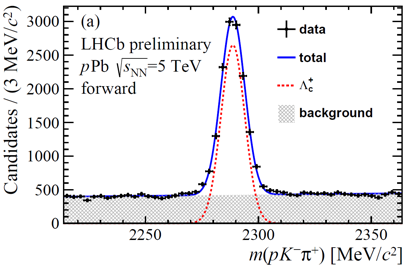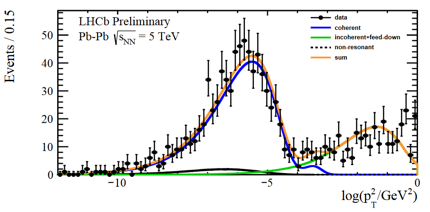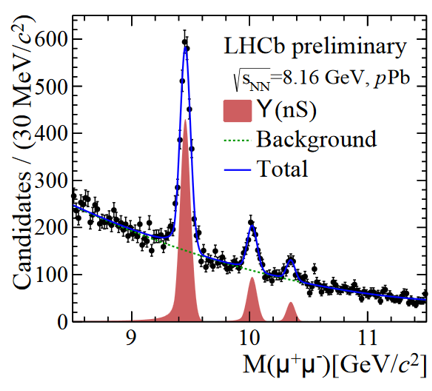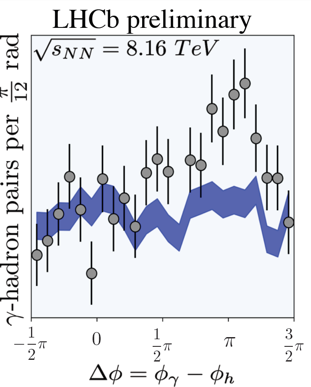The activities of the LHCb collaboration have expanded far beyond the original core aims. The excellent performance of the detector has allowed the experiment to make important contributions to a wide range of research sectors becoming in this way a general purpose detector in the forward region. The results presented this week at the Quark Matter 2018 conference in Venice, are a perfect example demonstrating such extended LHCb capabilities. In addition to measurements in the “standard” lead-lead ion (PbPb) and proton-lead ion (pPb) LHC collision conditions, LHCb has been able to perform measurements with data taken in a unique configuration: a fixed-target operational mode. In fact, the LHCb vertex locator (VELO) was built with the possibility of injecting gas at very-low pressure into the interaction region, allowing for recording collisions of the LHC circulating proton beams with target nuclei at rest. This mode has been so far succesfully operated with He, Ne and Ar gases.
The LHCb collaboration presented a wide range of results on charm production in various types of collisions. These include the production of the Λc baryon in pPb collisions and of D0 and J/ψ mesons in the fixed-target collisions with He and Ar. The production of heavy quarks in nucleus-nucleus interactions is well suited to the study of the transition between ordinary hadronic matter and the hot and dense Quark-Gluon Plasma (QGP). The production of J/ψ mesons in nucleus-nucleus interactions, its possible suppression in the quark-gluon medium and/or later charm-anti-charm quark recombination are all studied in order to shed light into the mechanisms governing such a phase transition. The LHCb pPb and fixed-target results utilising proton interactions with different nuclei at different energies provide precious reference results in conditions in which the formation of the QGP is not expected. The images above show a signal mass peak of Λc baryons decaying into a proton, a K and a π (above left) as well as of D0 mesons decaying into a K and a π (above right).
In ultra-relativistic heavy nuclei PbPb collisions, two-photon and photonuclear interactions are enhanced in ultra-peripheral collisions (UPC). The collisions are either coherent, where the photon couples coherently to all nucleons, or incoherent, where the photon couples to a single nucleon. In the case of coherent J/ψ production in UPC, the photon-lead interaction can be modelled by the exchange of a colourless propagator, identified as a single object called a Pomeron, that interacts with the photon. The LHCb collaboration reported at the conference the cross-section measurement of coherent J/ψ production in PbPb collisions at 5 TeV and compared this to predictions from different phenomenological models. The image shows that the coherent J/ψ production (blue line) can be clearly separated from the other contributions in the natural logarithm of the J/ψ transverse momentum squared distribution.
Bound states of heavy quark and antiquark, such as the charmonium J/ψ and ψ(2S) as well as the bottomonium Upsilon particles, are very important tools to study properties of the QGP. It is expected that the experimentally observed rate of different bound states should be modified depending on the temperature of the QGP. Therefore the measurement of charmonium and bottomonium suppression can be used as a kind of QGP thermometer. The left image above shows different Upsilon states measured in pPb collisions at √s=8.16 TeV as a clear example that the LHCb detector is very well armed to study this interesting physics sector owing to its excellent particle identification and mass resolution.
High-energy collisions involving ions have the best chance to produce gluon condensates, where the gluon wave functions start to overlap producing a collective behaviour. This condensate would be similar to the phenomenon predicted by Bose and Einstein 93 years ago and observed in other boson systems such as ultra-cold atoms. Saturated gluons are expected to be observed only at small angles relative to the beam axes, where the number and the size of the gluons are the largest. LHCb has the unique capability of measuring photons coming from these high density gluon regions. The announcement of initial measurements of these photons caused a lot of excitement at the Quark Matter conference. The image above (right) shows the angular distribution between isolated photons and other particles taken during the 2016 pPb run. This sample is from a region where theorists expect that gluons are saturated. The peak at the angle π indicates the presence of photons from gluons. The blue band is the background from other processes. This is the first indication that gluons can be probed in this region, never achieved by any experiment so far. Members of the theory community expressed interest in studying the upcoming LHCb results and are discussing the mathematical tools that can confirm the discovery of this new form of matter.
Read more in the LHCb presentations [1], [2], [3], [4] and [5]. The LHCb papers and conference contributions will be available shortly.





